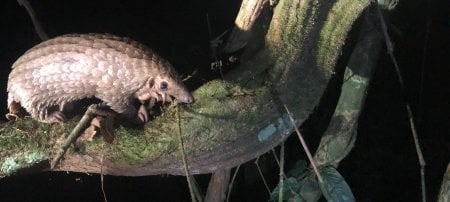Michigan Tech Graduate Student Aids International Bird Rescue Effort

Conservation could be Amber Roth’s middle name. She loves anything to do with nature. Birds, trees, grasses, ecosystems: she’s fascinated by it all.
So after tucking a Bachelor of Science in Conservation Biology and International Relations and a Master of Science in Wildlife Ecology under her belt, the Green Bay native came to Michigan Tech to earn a PhD in the School of Forest Resources and Environmental Science (SFRES).
Roth studies how to manage aspen forests to produce the maximum amount of biomass per acre without harming wildlife habitat. “It’s a management trade-off question,” she explains, and the basis of her PhD research
But Roth was raised by a devoted bird-watcher, and a tiny songbird that is facing hard times has also captured her heart. She has become an active member of the Golden-winged Warbler Working Group, an international conservation organization that spans two continents.
Weighing only 9 grams (equal to 4 dimes), the golden-winged warbler incredibly flies thousands of miles twice a year, migrating from its breeding grounds in the northern Midwest to its winter home in Central and South America. The tiny bird makes the long migration 6 to 10 times in a lifetime.
Its fuel efficiency is the equivalent of several hundred thousand miles per gallon,” Roth says with a smile.
But the far-flying warbler is in trouble. There used to be as many as half a million of the birds, and now there are fewer than 200,000. “Its numbers are declining sharply, and we don’t know why. We don’t know where the patient is bleeding,” says Roth.
The Golden-Winged Warbler Working Group got a small grant from the US Fish and Wildlife Service to try to determine what’s happening to the bird. Their research is a collaborative effort involving American, Canadian and Latin American scientists.
Some of the researchers are examining the bird’s genetics, to locate genetically pure populations. Only one has been found so far, in Manitoba, Canada. Others are studying the biochemical signature in the golden-winged warbler’s feathers, which can reveal where the young birds go after their first migration. And a third group is working to connect where the birds winter in Central and South America to where they breed.
It’s a real skin-and-bones project,” says Roth. But money isn’t the only resource the researchers need.
Michigan Tech has contributed 21 mist nets—fine nylon nets used to safely capture birds for study before releasing them. “These are older, damaged nets that I have in my lab, and the Latin American scientists know people who can repair them so that they can be reused,” SFRES associate professor David Flaspohler explains. Flaspohler is one of Roth’s PhD advisors, the other being Chris Webster.
If the nets were purchased new, they would cost as much as $100 each.
Like most of the other things she’s ever done, Roth says her work with the Golden-winged Warbler Working Group is helping prepare her for her dream career. With work experience in the Wisconsin Department of Natural Resources and her PhD from Michigan Tech, she’s looking forward to climbing what she calls her “career triangle”—comprising research, education and conservation management. “I like being involved in all three,” she says, “the research, the outreach, and the management on the ground.”
Michigan Technological University is an R1 public research university founded in 1885 in Houghton, and is home to nearly 7,500 students from more than 60 countries around the world. Consistently ranked among the best universities in the country for return on investment, Michigan's flagship technological university offers more than 185 undergraduate and graduate degree programs in science and technology, engineering, computing, forestry, business, health professions, humanities, mathematics, social sciences, and the arts. The rural campus is situated just miles from Lake Superior in Michigan's Upper Peninsula, offering year-round opportunities for outdoor adventure.




Comments